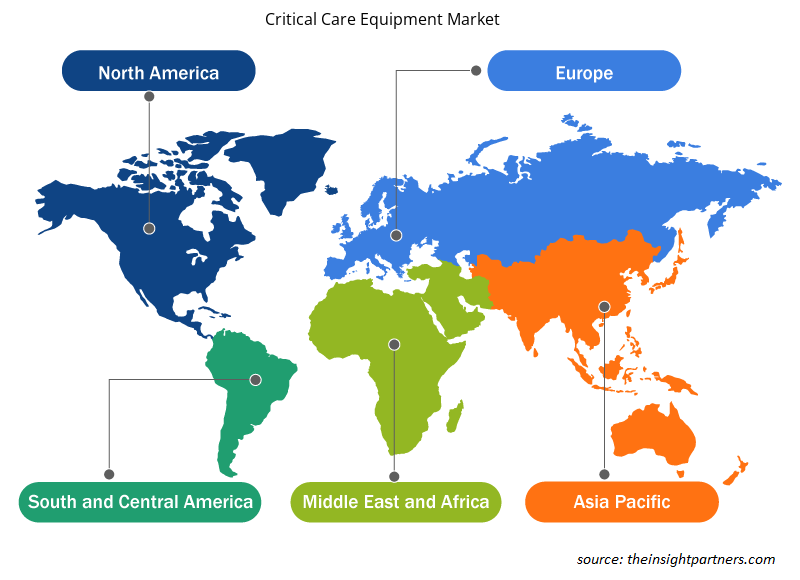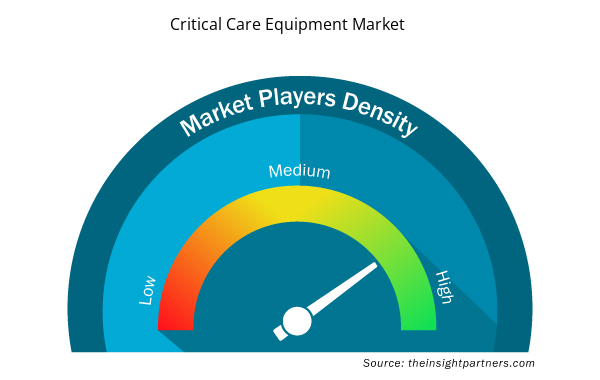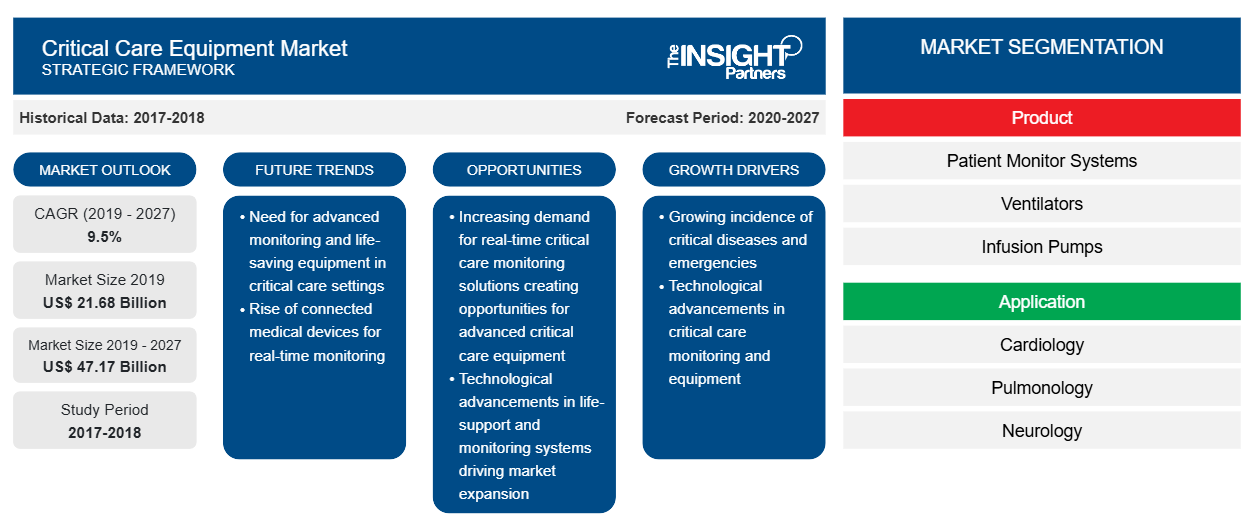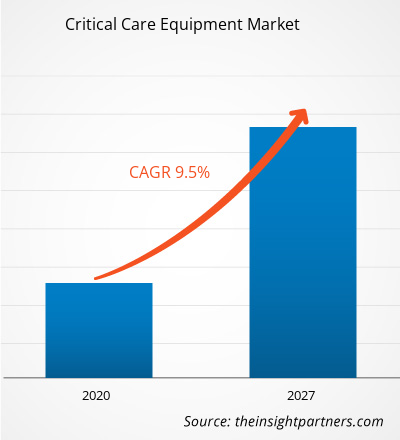El mercado de equipos de cuidados críticos se valoró en US$ 21.682,65 millones en 2019 y se proyecta que alcance los US$ 47.171,42 millones en 2027; se espera que crezca a una CAGR del 9,5% durante 2020-2027.
Los pacientes con la infección pasan una media de 15 días en la UCI. Según la Sociedad Europea de Anestesiología, el número de camas de cuidados intensivos en Italia sigue creciendo. En Lombardía, antes de la propagación del coronavirus, había 140 camas de UCI privadas y 500 camas de cuidados intensivos (UCI) públicas, que aumentaron a más de 900 a finales de marzo de 2020.
Personalice este informe según sus necesidades
Obtendrá personalización en cualquier informe, sin cargo, incluidas partes de este informe o análisis a nivel de país, paquete de datos de Excel, así como también grandes ofertas y descuentos para empresas emergentes y universidades.
- Obtenga las principales tendencias clave del mercado de este informe.Esta muestra GRATUITA incluirá análisis de datos, desde tendencias del mercado hasta estimaciones y pronósticos.
Perspectivas del mercado
El creciente número de camas de UCI en países con alta prevalencia de COVID-19 impulsará el crecimiento del mercado
El 11 de marzo de 2020, la Organización Mundial de la Salud declaró la COVID-19 como una pandemia mundial. Esta nueva enfermedad se caracteriza por un menor número de casos iniciales seguido de una explosión de infecciones en varios países. A pesar de la implementación de confinamientos para reducir la propagación de la COVID-19, los sistemas de atención médica en varios países se han visto desbordados por la demanda de equipos, como camas de UCI y equipos de apoyo para tratar los casos graves de la enfermedad.
Información sobre productos
En términos de productos, el segmento de sistemas de monitorización de pacientes tuvo la mayor participación del mercado en 2019 y se espera que continúe siendo un accionista líder durante el período de pronóstico. Sin embargo, se espera que el segmento de respiradores registre una CAGR más alta en el mercado durante el período de pronóstico.
Información sobre aplicaciones
Según la aplicación, el mercado mundial de equipos de cuidados críticos está segmentado en cardiología, neumología, neurología, ortopedia y otros. El segmento de cardiología tuvo la mayor participación del mercado en 2019, y se espera que el segmento de neumología registre la CAGR más alta durante el período de pronóstico. Los cuidados intensivos cardiovasculares son el manejo sistémico de pacientes con enfermedad cardiovascular (ECV) grave, incluidas las enfermedades vasculares y las enfermedades cardíacas. La ECV se encuentra entre las principales causas de muerte en todo el mundo. Por ejemplo, según la Organización Mundial de la Salud, en 2016, se estima que 17,9 millones de personas murieron por ECV, lo que representa el 31% de las muertes en todo el mundo. De manera similar, según los Centros para el Control y la Prevención de Enfermedades, alrededor de 655.000 estadounidenses mueren de enfermedades cardíacas cada año. Para prevenir la muerte por ECV, los hospitales generales disponen de una unidad de cuidados intensivos para pacientes con ECV grave, es decir, la unidad de cuidados intensivos cardiovasculares (UCIC). Los avances tecnológicos de la cardiología clínica, como los procedimientos y dispositivos de intervención intracoronaria y la monitorización hemodinámica invasiva, son las principales evoluciones de los cuidados intensivos para las ECV. En consecuencia, el número de pacientes con ECV grave ingresados en la UCIC crece cada año. Los pacientes de la UCIC presentan muchas complicaciones, como insuficiencia respiratoria e insuficiencia renal. Por lo tanto, se necesita personal médico capacitado para practicar cuidados intensivos sistémicos.
Se prevé que las colaboraciones y asociaciones tecnológicas de los actores del mercado de equipos de cuidados críticos para cerrar la brecha entre la oferta y la demanda desempeñarán un papel importante en el crecimiento del mercado durante el período de pronóstico.
Perspectivas regionales del mercado de equipos de cuidados intensivos
Los analistas de Insight Partners explicaron en detalle las tendencias y los factores regionales que influyen en el mercado de equipos de cuidados intensivos durante el período de pronóstico. Esta sección también analiza los segmentos y la geografía del mercado de equipos de cuidados intensivos en América del Norte, Europa, Asia Pacífico, Oriente Medio y África, y América del Sur y Central.

- Obtenga datos regionales específicos para el mercado de equipos de cuidados intensivos
Alcance del informe de mercado de equipos de cuidados intensivos
| Atributo del informe | Detalles |
|---|---|
| Tamaño del mercado en 2019 | US$ 21.68 mil millones |
| Tamaño del mercado en 2027 | US$ 47,17 mil millones |
| CAGR global (2019-2027) | 9,5% |
| Datos históricos | 2017-2018 |
| Período de pronóstico | 2020-2027 |
| Segmentos cubiertos | Por producto
|
| Regiones y países cubiertos | América del norte
|
| Líderes del mercado y perfiles de empresas clave |
|
Densidad de actores del mercado de equipos de cuidados intensivos: comprensión de su impacto en la dinámica empresarial
El mercado de equipos de cuidados intensivos está creciendo rápidamente, impulsado por la creciente demanda de los usuarios finales debido a factores como la evolución de las preferencias de los consumidores, los avances tecnológicos y una mayor conciencia de los beneficios del producto. A medida que aumenta la demanda, las empresas amplían sus ofertas, innovan para satisfacer las necesidades de los consumidores y aprovechan las tendencias emergentes, lo que impulsa aún más el crecimiento del mercado.
La densidad de actores del mercado se refiere a la distribución de las empresas o firmas que operan dentro de un mercado o industria en particular. Indica cuántos competidores (actores del mercado) están presentes en un espacio de mercado determinado en relación con su tamaño o valor total de mercado.
Las principales empresas que operan en el mercado de equipos de cuidados críticos son:
- Compañía General Electric
- Medtronic
- B. Braun Melsungen AG
- Baxter Internacional Inc.
- Philips NV, la línea Koninklijke
Descargo de responsabilidad : Las empresas enumeradas anteriormente no están clasificadas en ningún orden particular.

- Obtenga una descripción general de los principales actores clave del mercado de equipos de cuidados críticos
Por producto
- Sistemas de monitorización de pacientes
- Ventiladores
- Ventiladores invasivos
- Ventiladores no invasivos
- Bombas de infusión
- Otros
Por aplicación
- Cardiología
- Neumología
- Neurología
- Ortopédico
- Otros
Por el usuario final
- Hospitales
- Centros de atención ambulatoria
- Cuidados en el hogar
- Otros
Por geografía
- América del norte
- A NOSOTROS
- Canadá
- México
- Europa
- Francia
- Alemania
- Italia
- Reino Unido
- Rusia
- Asia Pacífico (APAC)
- Porcelana
- India
- Corea del Sur
- Japón
- Australia
- Oriente Medio y África (MEA)
- Sudáfrica
- Arabia Saudita
- Emiratos Árabes Unidos
- América del Sur y Central (SCAM)
- Brasil
- Argentina
Perfiles de empresas
- Compañía General Electric
- Medtronic
- B. Braun Melsungen AG
- Baxter Internacional Inc.
- Philips NV, la línea Koninklijke
- Getinge AB
- Médico Hamilton
- Löwenstein Medical UK Ltd.
- Dragerwerk AG & Co. KGaA
- Corporación Nihon Kohden
- Compañía: Fisher & Paykel Healthcare Limited.
- Shenzhen Mindray Electrónica Biomédica Co., Ltd.
- BPL
- Atención sanitaria Trivitron
- SKANRAY TECHNOLOGIES PVT LTD.
- Corporación Asahi Kasei
- Análisis histórico (2 años), año base, pronóstico (7 años) con CAGR
- Análisis PEST y FODA
- Tamaño del mercado Valor/volumen: global, regional, nacional
- Industria y panorama competitivo
- Conjunto de datos de Excel


- Fishing Equipment Market
- Advanced Planning and Scheduling Software Market
- Lyophilization Services for Biopharmaceuticals Market
- Pressure Vessel Composite Materials Market
- Adaptive Traffic Control System Market
- Dealer Management System Market
- Online Exam Proctoring Market
- Electronic Toll Collection System Market
- Underwater Connector Market
- Saudi Arabia Drywall Panels Market

Report Coverage
Revenue forecast, Company Analysis, Industry landscape, Growth factors, and Trends

Segment Covered
This text is related
to segments covered.

Regional Scope
North America, Europe, Asia Pacific, Middle East & Africa, South & Central America

Country Scope
This text is related
to country scope.
Preguntas frecuentes
The disruption of supply chain and logistics due to the rapid spread of COVID-19 is the significant factor that will hinder the critical care equipment market growth.
The global critical care equipment market is being driven by factors such growing number of ICU beds in countries with a high prevalence of COVID-19 and increasing demand for ventilators for the effective management of critical COVID-19 patients. Furthermore, technological innovations in critical care equipment is likely to offer significant opportunities for the growth of the global critical care equipment market.
Critical care equipment includes cardiac support, patient monitoring, respiratory support, emergency resuscitation devices, pain management, and other life support equipment designed to care for critically ill patients or have undergone a major surgical procedure, thereby requiring 24-hour care monitoring.
Trends and growth analysis reports related to Life Sciences : READ MORE..
The List of Companies - Critical Care Equipment Market
- General Electric Company
- Medtronic
- B. Braun Melsungen AG
- Baxter International Inc.
- Koninklijke Philips N.V.
- Getinge AB
- Hamilton Medical
- Löwenstein Medical UK Ltd.
- Dragerwerk AG & Co. KGaA
- Nihon Kohden Corporation
- Fisher & Paykel Healthcare Limited.
- Shenzhen Mindray Biomedical Electronics Co., Ltd.
- BPL
- Trivitron Healthcare
- Skanray Technologies Pvt Ltd
- Asahi Kasei Corporation
The Insight Partners performs research in 4 major stages: Data Collection & Secondary Research, Primary Research, Data Analysis and Data Triangulation & Final Review.
- Data Collection and Secondary Research:
As a market research and consulting firm operating from a decade, we have published and advised several client across the globe. First step for any study will start with an assessment of currently available data and insights from existing reports. Further, historical and current market information is collected from Investor Presentations, Annual Reports, SEC Filings, etc., and other information related to company’s performance and market positioning are gathered from Paid Databases (Factiva, Hoovers, and Reuters) and various other publications available in public domain.
Several associations trade associates, technical forums, institutes, societies and organization are accessed to gain technical as well as market related insights through their publications such as research papers, blogs and press releases related to the studies are referred to get cues about the market. Further, white papers, journals, magazines, and other news articles published in last 3 years are scrutinized and analyzed to understand the current market trends.
- Primary Research:
The primarily interview analysis comprise of data obtained from industry participants interview and answers to survey questions gathered by in-house primary team.
For primary research, interviews are conducted with industry experts/CEOs/Marketing Managers/VPs/Subject Matter Experts from both demand and supply side to get a 360-degree view of the market. The primary team conducts several interviews based on the complexity of the markets to understand the various market trends and dynamics which makes research more credible and precise.
A typical research interview fulfils the following functions:
- Provides first-hand information on the market size, market trends, growth trends, competitive landscape, and outlook
- Validates and strengthens in-house secondary research findings
- Develops the analysis team’s expertise and market understanding
Primary research involves email interactions and telephone interviews for each market, category, segment, and sub-segment across geographies. The participants who typically take part in such a process include, but are not limited to:
- Industry participants: VPs, business development managers, market intelligence managers and national sales managers
- Outside experts: Valuation experts, research analysts and key opinion leaders specializing in the electronics and semiconductor industry.
Below is the breakup of our primary respondents by company, designation, and region:

Once we receive the confirmation from primary research sources or primary respondents, we finalize the base year market estimation and forecast the data as per the macroeconomic and microeconomic factors assessed during data collection.
- Data Analysis:
Once data is validated through both secondary as well as primary respondents, we finalize the market estimations by hypothesis formulation and factor analysis at regional and country level.
- Macro-Economic Factor Analysis:
We analyse macroeconomic indicators such the gross domestic product (GDP), increase in the demand for goods and services across industries, technological advancement, regional economic growth, governmental policies, the influence of COVID-19, PEST analysis, and other aspects. This analysis aids in setting benchmarks for various nations/regions and approximating market splits. Additionally, the general trend of the aforementioned components aid in determining the market's development possibilities.
- Country Level Data:
Various factors that are especially aligned to the country are taken into account to determine the market size for a certain area and country, including the presence of vendors, such as headquarters and offices, the country's GDP, demand patterns, and industry growth. To comprehend the market dynamics for the nation, a number of growth variables, inhibitors, application areas, and current market trends are researched. The aforementioned elements aid in determining the country's overall market's growth potential.
- Company Profile:
The “Table of Contents” is formulated by listing and analyzing more than 25 - 30 companies operating in the market ecosystem across geographies. However, we profile only 10 companies as a standard practice in our syndicate reports. These 10 companies comprise leading, emerging, and regional players. Nonetheless, our analysis is not restricted to the 10 listed companies, we also analyze other companies present in the market to develop a holistic view and understand the prevailing trends. The “Company Profiles” section in the report covers key facts, business description, products & services, financial information, SWOT analysis, and key developments. The financial information presented is extracted from the annual reports and official documents of the publicly listed companies. Upon collecting the information for the sections of respective companies, we verify them via various primary sources and then compile the data in respective company profiles. The company level information helps us in deriving the base number as well as in forecasting the market size.
- Developing Base Number:
Aggregation of sales statistics (2020-2022) and macro-economic factor, and other secondary and primary research insights are utilized to arrive at base number and related market shares for 2022. The data gaps are identified in this step and relevant market data is analyzed, collected from paid primary interviews or databases. On finalizing the base year market size, forecasts are developed on the basis of macro-economic, industry and market growth factors and company level analysis.
- Data Triangulation and Final Review:
The market findings and base year market size calculations are validated from supply as well as demand side. Demand side validations are based on macro-economic factor analysis and benchmarks for respective regions and countries. In case of supply side validations, revenues of major companies are estimated (in case not available) based on industry benchmark, approximate number of employees, product portfolio, and primary interviews revenues are gathered. Further revenue from target product/service segment is assessed to avoid overshooting of market statistics. In case of heavy deviations between supply and demand side values, all thes steps are repeated to achieve synchronization.
We follow an iterative model, wherein we share our research findings with Subject Matter Experts (SME’s) and Key Opinion Leaders (KOLs) until consensus view of the market is not formulated – this model negates any drastic deviation in the opinions of experts. Only validated and universally acceptable research findings are quoted in our reports.
We have important check points that we use to validate our research findings – which we call – data triangulation, where we validate the information, we generate from secondary sources with primary interviews and then we re-validate with our internal data bases and Subject matter experts. This comprehensive model enables us to deliver high quality, reliable data in shortest possible time.


 Obtenga una muestra gratuita de este informe
Obtenga una muestra gratuita de este informe